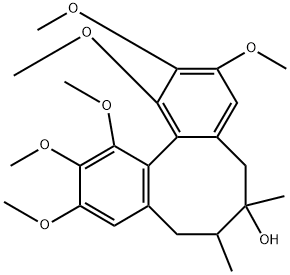Physicochemical Properties
| Molecular Formula | C24H32O7 |
| Molecular Weight | 432.51 |
| Exact Mass | 432.214 |
| CAS # | 7432-28-2 |
| Related CAS # | Schisandrin B;61281-37-6;Schisandrin C;61301-33-5;Schisandrin A;61281-38-7 |
| PubChem CID | 3001664 |
| Appearance | White to light yellow solid powder |
| Density | 1.1±0.1 g/cm3 |
| Boiling Point | 576.7±50.0 °C at 760 mmHg |
| Melting Point | 128-129ºC |
| Flash Point | 302.6±30.1 °C |
| Vapour Pressure | 0.0±1.7 mmHg at 25°C |
| Index of Refraction | 1.535 |
| LogP | 4.18 |
| Hydrogen Bond Donor Count | 1 |
| Hydrogen Bond Acceptor Count | 7 |
| Rotatable Bond Count | 6 |
| Heavy Atom Count | 31 |
| Complexity | 574 |
| Defined Atom Stereocenter Count | 2 |
| SMILES | O([H])[C@]1(C([H])([H])[H])C([H])([H])C2=C([H])C(=C(C(=C2C2=C(C(=C(C([H])=C2C([H])([H])[C@]1([H])C([H])([H])[H])OC([H])([H])[H])OC([H])([H])[H])OC([H])([H])[H])OC([H])([H])[H])OC([H])([H])[H])OC([H])([H])[H] |
| InChi Key | YEFOAORQXAOVJQ-RZFZLAGVSA-N |
| InChi Code | InChI=1S/C24H32O7/c1-13-9-14-10-16(26-3)20(28-5)22(30-7)18(14)19-15(12-24(13,2)25)11-17(27-4)21(29-6)23(19)31-8/h10-11,13,25H,9,12H2,1-8H3/t13-,24-/m0/s1 |
| Chemical Name | (9S,10S)-3,4,5,14,15,16-hexamethoxy-9,10-dimethyltricyclo[10.4.0.02,7]hexadeca-1(16),2,4,6,12,14-hexaen-9-ol |
| Synonyms | Magnolia Vine Gomisins Schizandrin |
| HS Tariff Code | 2934.99.9001 |
| Storage |
Powder-20°C 3 years 4°C 2 years In solvent -80°C 6 months -20°C 1 month |
| Shipping Condition | Room temperature (This product is stable at ambient temperature for a few days during ordinary shipping and time spent in Customs) |
Biological Activity
| ln Vitro | In RAW 264.7 cells, schisandrin (10-100 μM; 2 h pretreatment) dose-dependently suppresses LPS-stimulated NO generation, iNOS protein, and mRNA expression [1]. In LPS-stimulated RAW 264.7 macrophages, schisandrin (25–100 μM; 2 hours pretreatment) suppresses prostaglandin E2 synthesis, COX-2 protein, and mRNA expression [1]. SK-HEP-1, SNU-638, and T47D cell proliferation is inhibited by schisandrin, with IC50 values of 42.0, 53.1, and 40.0 μM, respectively [3]. Schisandrin (10–60 μM; 48 hours) preferentially reverses MCF-7/DOX resistance and amplifies apoptosis elicited by doxorubicin [4]. |
| ln Vivo | In mice, schisandrin (10–100 mg/kg; single intraperitoneal injection) decreases paw edema brought on by carrageenan and prevents peritoneal vascular permeability brought on by acetic acid [1]. Schisandrin (1–10 mg/kg; single oral dosage) dramatically improves oxotremorine-induced tremor in rats and overcomes scopolamine-induced deficits in spatial memory and passive avoidance responses [2]. |
| Cell Assay |
Cell viability assay [1] Cell Types: RAW 264.7 Macrophage Tested Concentrations: 12.5, 25, 50, 100 μM Incubation Duration: Pretreatment for 2 hrs (hours), then incubated with LPS (1 μg/mL) for 18 hrs (hours) Experimental Results: iNOS protein expression demonstrated significant in a dose-dependent manner. Dramatically inhibits COX-2 protein expression. |
| Animal Protocol |
Animal/Disease Models: Male ICR mice (4 weeks) were intraperitoneally (ip) (ip) injected with λ-carrageenan [1] in the right hind paw. Doses: 100, 200 mg/kg. Route of Administration: single ip. Experimental Results: Inhibited paw edema by 33.43% (100 mg /kg) and 57.38 % (200 mg/kg) at 3 hrs (hrs (hours)). |
| References |
[1]. Anti-inflammatory effects of schisandrin isolated from the fruit of Schisandra chinensis Baill. Eur J Pharmacol. 2008 Sep 4;591(1-3):293-9. [2]. Schizandrin reverses memory impairment in rats. Phytother Res. 2008 Jan;22(1):49-52. [3]. Antiproliferative effects of dibenzocyclooctadiene lignans isolated from Schisandra chinensis in human cancer cells. Bioorg Med Chem Lett. 2008 Jan 15;18(2):523-6. [4]. Schisandrin A reverses doxorubicin-resistant human breast cancer cell line by the inhibition of P65 and Stat3 phosphorylation. Breast Cancer. 2018 Mar;25(2):233-242. |
| Additional Infomation |
Schizandrin has been reported in Schisandra bicolor, Kadsura interior, and other organisms with data available. See also: Schisandra chinensis fruit (part of). |
Solubility Data
| Solubility (In Vitro) | DMSO : ~1 mg/mL (~2.31 mM) |
| Solubility (In Vivo) |
Solubility in Formulation 1: ≥ 0.28 mg/mL (0.65 mM) (saturation unknown) in 10% DMSO + 40% PEG300 +5% Tween-80 + 45% Saline (add these co-solvents sequentially from left to right, and one by one), clear solution. For example, if 1 mL of working solution is to be prepared, you can add 100 μL of 2.8 mg/mL clear DMSO stock solution to 400 μL PEG300 and mix evenly; then add 50 μL Tween-80 + to the above solution and mix evenly; then add 450 μL normal saline to adjust the volume to 1 mL. Preparation of saline: Dissolve 0.9 g of sodium chloride in 100 mL ddH₂ O to obtain a clear solution. (Please use freshly prepared in vivo formulations for optimal results.) |
| Preparing Stock Solutions | 1 mg | 5 mg | 10 mg | |
| 1 mM | 2.3121 mL | 11.5604 mL | 23.1209 mL | |
| 5 mM | 0.4624 mL | 2.3121 mL | 4.6242 mL | |
| 10 mM | 0.2312 mL | 1.1560 mL | 2.3121 mL |
